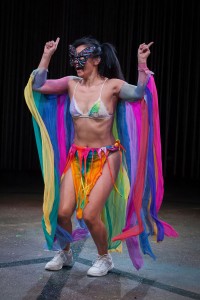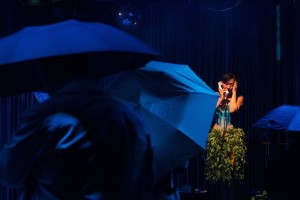If you just can’t wait for the transatlantic transfer of the hit West End Cabaret that was recently announced, cheer up, there’s another Nazi musical in town. That would be Chanteuse, the bleak and arresting solo tale of the remarkable fate of one gay man in Weimar and post-Weimar Germany. The performer, Alan Palmer, also wrote the book and lyrics, while the curiously soothing music is by David Legg. Chanteuse has a frightening and touching story to tell, but you might not be entirely on board with the way it gets told.
The Private Is Now Public
Who doesn’t feel good when a posting on Facebook gets lots of “likes”? It’s a place where, when something momentous in your life happens, like a marriage, or a death, your FB friends—all hundreds of them—can give you a virtual hug. It’s also where the theater company Five on a Match culled the dialogue to create its production of Seen/By Everyone, directed by Kristin Marting at HERE Theater. Although the production feels fragmented—it’s nonlinear in both story line and dialogue—it does resonate. Primarily, it asks the question through the production itself: what is the effect of social media on our lives? It’s not an original question, and certainly not one that can be definitely answered, but it’s one worth considering from time to time.
The creators (Matthew Cohn, Amir Darvish, Meg MacCary, Enormvs Muñoz, and Jean Taher) use Facebook as a starting point, and every word in the show is from Facebook posts. The play, however, is not a head-on commentary on social media, but rather about the weight and depth of what is shared in this milieu. The writers focused on two major themes: relationships and death, and as in real life, conversation about these topics may be scaled down to their lowest common denominator, or fragmented. Also true to life is the pattern of everyday communication in which we respond to immediacy of information, as well as the tendency to meander down many different roads. No wonder we love social media so much: it mirrors our needs and patterns of communication so perfectly.
The play begins with a death, and picks up different fragments of different stories about relationships. One character, a perky but lost-looking character named Maggie (Alesandra Nahodil), dressed in a pleated white skirt and a crocheted blouse (costumes are by Oana Botez), sits at a bar. She says, “I made up a birthday so I felt justified getting wasted today.” Then, “I’m good at being homeless. But not that good.” The Bartender, dressed in tremendously tall lace-up platform boots, like the gatekeeper to a leather bar, addresses her with platitudes: “It’s OK to be alone,” he repeats over and over. Later, he gives her a list of all the things she can do to feel better: “write a story, read a new book or magazine, take a nap.” She seems unappeased. Later we learn why. She’s restless but not for the reasons we think. It’s a part of the play that remains a mystery until the end. However, in his attempt to soothe her, the gatekeeper/bartender (as usual) turns out to be the wisest one.
In some scenes, more naturalistic acting and narrative bring characters together. They gather at the bar, or at tall, round tables in the center of the space and gossip, fight, laugh, cry and over share. At one point, Rose (Katie Brustele) and Bernice (Jen Taher) exchange superficial tidbits. Bernice aptly launches into a diatribe about the elimination diet she’s doing in which she can’t eat any “gluten anything, no corn, soy, chocolate, booze, pork/beef/shellfish, no dairy/cheese/yogurt/egg, no sugar, maple syrup, agave, or honey.” It’s funny because it’s timely. Everyone knows someone, or knows of someone, who is consciously taking something out of their diet.
Without the development of characterization and a story line, however, it’s hard to get a sense of who these characters are. When Bernice accuses Fred (RollsAndre) of being cynical, we have to take her word. In this world, we have to take the other’s word, and there is some suggestion that social media nullifies our individuality. This is particularly implied when actors don masks with mirrored tiles, and line up. The masks make them faceless, and take away their individually, perhaps representative of the virtual FB community that is based on photos, disembodied words, and still images, rather than real interactive ones.
The experience of watching Seen/By Everyone can be disorienting if you’re not willing to leave your typical theatergoing road map of expectations behind. In the end, it offers a thought-provoking experience about the nature of what happens when important events, or everyday issues, are filtered through the lens of sharing vis-à-vis Facebook, a place where our identities are easily socially constructed, and where information, when isolated, can be disembodied.
Five on a Match’s world premiere of Seen/By Everyone runs through June 25 at HERE (145 6th Ave.; entrance on Dominick Street). Performances are at 8:30 p.m. June 16-19 and 22-25. Tickets are $25 and may be purchased online at http://www.seenbyeveryone.com/tickets/.
The Real Change Agent
While some viewed Kathy Change as the flag woman who shouted nonsense and danced for hours on the University of Pennsylvania campus, others saw her as a legendary political activist who sacrificed her life in order to spread her message to the world.
So who was Kathy Change? Based on a true story, the play Chang(e) captures the last few years of Change’s life and humanizes this historical woman. As an activist in the late '80s and early '90s, Change committed to transforming the world through speech and dance. She believed that our country had a corrupt government that would leave us into an economic fall and war with Iraq, and that the only way to stop those events was the mobilization of a loving and peaceful democracy. Despite Change's revolutionary leadership, her eccentric behavior caused some people to ignore her powerful words.
Aside from her activism career, Change attempted suicide multiple times and blamed herself for her mother’s death. What kept her alive (and eventually led to her death) was her need for people to acknowledge that a transformation was needed in our world immediately. With a megaphone in her hand or with her body dancing in the breeze, she tried to convince people that this transformation can only begin from within by changing how we think and spreading love to others.
With a combination of theater, dance and movement, Soomi Kim and Suzi Takahashi devised Chang(e) in order to capture the many facets of Change. Within the play, the audience is able to see when Change is coherent and articulates her beliefs with vigor and clarity. These scenes stream seamlessly with Change’s conflicting states where she is high on drugs or stuck in her own head. Since the audience also feels like they're tripping on drugs, it's often difficult to discern imagination with reality in this production.
The play's black box is transformed with a hippie theme. With a huge peace sign painted on the ground, disco balls hanging from the ceiling and Chinese lanterns lighting up the room, the set designed by Bryce Cutler was without a doubt constructed with the '80s in mind. Along with strips of white cloth as a backdrop, the flowing fabric allows for easy entrances and exits as well as a screen for projection.
The projection and videos by Kevan Loney were incredible in multiple ways. Projected on the backdrop and floor, the projection adds a larger depth to the show by including psychedelic images that bring us into the world of Change’s alternate reality. It literally transports the audience into the mind of Change that was absolutely necessary to the play's story line. During the production, Kim embodies Change by interacting with the projection by dancing and moving around it as if the images have come to life. These projections become part of the set that she uses in order to share Change's story. In addition, it allowed the company to include a video of Brendan McGeever's first-hand account of Change's impact. This retelling helped the audience humanize the misunderstood and radical leader.
Kim was passionate about sharing the story of Change and only naturally played the part of this historical Asian-American. The years of research was evident in her acting. She was confident with every line, every scene and every movement as if she was the woman herself. Kim shows her talent through her ability of changing between the confident Change to the unsteady Change that seemed to almost be on the brink of insanity.
The ensemble consisted of six actors—Ben Skalski, David Perez-Ribada, Kiyoko Kashiwagi, Criena House, Adriana Spencer and Zek Stewart. Their talent was clearly apparent in their unparalleled versatility to play multiple characters. This helped the scenes flow smoothly without any confusion between the characters.
Overall, this show highlights how Kathy Change is an example of a brilliant person who continually fights the demons in the world and in her mind. Chang(e) is for audience members who want to see a non-traditional play that captures the life of a non-traditional woman.
Soomi Kim and Suzi Takahashi's Chang(e) is playing at HERE (145 Sixth Ave.) in Manhattan through Nov. 22. Performances are Thursday-Saturday at 8:30 p.m. and Sunday at 4 p.m. Tickets are $18. For tickets, call 212-352-3101 or visit www.here.org.











